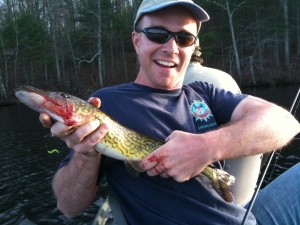It’s funny sometimes how seemingly unrelated events help to congeal an idea in your head (or in my case remind you of an idea that you had thought about before, and then forgotten…I am 40 after all!).
Earlier this week I finally checked out the NPR story that Don Waye from EPA had sent, that had been composting in my inbox. It was an interview with William Ruckelshaus, the first administrator of EPA, who was largely responsible with implementing the Clean Water Act 40 years ago (read the interview,
A Look Back at the Birth of the Clean Water Act). He simply but eloquently described the atmosphere at the time, and the events that led up to the establishment of EPA and the CWA, which included public response to Rachel Carson’s “Silent Spring” in the 1960’s, and the large public outcry against widespread water pollution that led to rivers catching fire and grossly contaminated waterways.
On Wednesday evening, I was asked to give a presentation on rain gardens to a local group called “Friends of Bolton Lakes.” I have given many of these presentations, sometimes to small crowds, sometimes to larger crowds. This was a very large crowd, and the energy and concern in the room struck me. These local citizens were very concerned about their lakes (it is actually a series of three lakes, but the lower one has had the most problems. See http://www.wfsb.com/story/19385160/toxic-blue-green-algae-bloom-reported-at-bolton-lake). Last summer there was a major bloom of nuisance weeds and a toxic algae, which led to the closure of the public beach. Residents were unable to use their precious resource. These residents were contributing their money and their time to help solve the problem. A local state representative was at the meeting, and had put forth a bill to address the issue.

As educators we have all struggled at times with trying to get the right message out to inspire people who attend our workshops, and ultimately get them to change a behavior that is causing a problem. So this is the point of my story today: when people have an emotional tie to something, they are very motivated to act. This was true in the late 1960s and 1970s, and it is true now. I have been involved with and read about quite a few projects where the goal was to get citizens to implement some kind of behavior change to improve water quality. The common thread among the projects that generate large public action and implementation seems to be an emotional attachment to a local resource. Another project in Massachusetts illustrates this: Long Lake in Littleton had high levels of bacteria in the lake, which was causing beach closures. Local residents became heavily involved with building rain gardens and implementing other practices to reduce stormwater discharges to the lake (GeoSyntec consultants managed this project). Water quality improved.
The message that is reinforced here for me (and I am not the first one to say this) is that we need to make sure we are tying our messages in to local problems. This is the case for water issues, or other things like climate change as well; long-term climate change is a very abstract, uncertain idea for most people, until there is a local impact to them. Part of this is due to our nature—the human brain is well adapted to respond to immediate threats, but longer term threats do not bring about the same reaction. This is related to risk perception, and has been documented in the literature (see Weber, E.U. 2006. Experience-based and description-based perceptions of long-term risk: why global warming does not scare us (yet). Climate Change, Vol. 77, pp. 103-120.
The events of this week gave me new energy to engage the public in our educational efforts. We are all aware of these emotional connections; I used to fish and swim in Bolton Lake. Perhaps you have a favorite beach that was heavily damaged by Sandy. Bringing about these emotional responses in citizens is the key to getting them to act. I reinforced to the citizens at the meeting in Bolton how much power they have; I relayed the story of the public outcry 40 years ago, and the amazing changes in water quality that have resulted. There are times when we need to present facts and figures to people to relay a concept, but from now on I will always try to think about a way to tie in a local message in my educational programs. If you see me forget…just remind me…after all, I am 40!
-MD